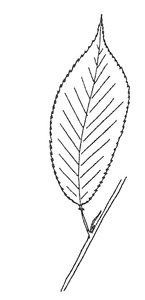Prunus americana (proo’-nus ah-mere-uh-kah’-nah)
Family: Rosaceae, Rose
Key Steps
- 1b – Alternate leaf arrangement — go to 18
Description
 Leaf: 1-5 inches long, hairless or nearly so. Petiole hairy on upper side. Leaf somewhat sharply pointed, narrowing abruptly to a long tip. Broadest at or above middle. Sharply and often doubly toothed. May or may not have glands (tiny bumps or knobs) at top of petiole. Net-like veins. Long narrow stipules usually present.
Leaf: 1-5 inches long, hairless or nearly so. Petiole hairy on upper side. Leaf somewhat sharply pointed, narrowing abruptly to a long tip. Broadest at or above middle. Sharply and often doubly toothed. May or may not have glands (tiny bumps or knobs) at top of petiole. Net-like veins. Long narrow stipules usually present.
Bud: True terminal bud absent. Lateral buds are reddish-brown, 1/8 to 1/2 inch long. Sharp pointed. Lighter colored and downy at scale margins.
Leaf Scar: Raised, oblong, more than 1 bundle scar (hard to see). Base of scar is darker than rest of scar or stem.
Stem: Stout and stiff. May be angled at nodes. Light colored lenticels. Typically hairless, grayish film. Usually has long, blunt thorns on older branches. Spine-like lateral spurs 2nd year. New growth is orange-brown.
Bark: Shaggy older bark.
Pith: Solid, small, round. May be brown in some areas of stem, white in other areas.
Flower: White, fragrant, 1 inch across, 5 petals. Blooms just as leaves appear. Clusters of 3-5 flowers together at end of spur or from lateral buds.
Fruit: Red, yellow, or purple plum with slight bloom (powdery). 1″ diameter. Large seed, somewhat flattened.
Habit: Small tree. Low, broad crown. Suckers; can be multi-stemmed and form a thicket. Usually 20 feet tall or smaller. Colorado Native to plains, foothills, canyons, and slope bottoms.
Culture: Low moisture requirement. Cold and drought tolerant.
Resources




